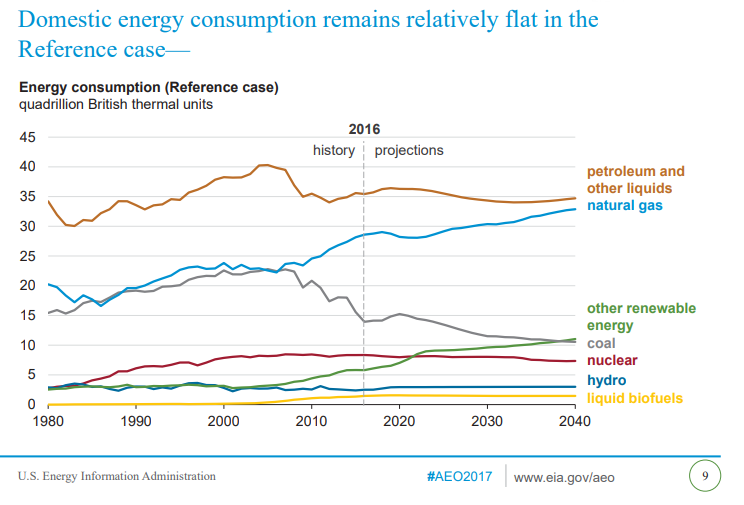WHILE MOST BELIEVE THE TRANSITION TO RENEWABLE FUELS IS IN PROGRESS AND WILL BE COMPLETED SOON, THE FACT IS THAT THE US GOV BELIEVES RENEWABLES WILL STILL BE A TINY PERCENTAGE OF OUR CONSUMPTION IN 2040.
The US Department of Energy prepares an annual energy output, continuously updated and located here. It’s instructive to look at the most recent to see where the government believes our consumption is headed in 2040. The summary is in the graph below:
The Y axis is “quadrillion”, which is 10^15. Conveniently, in 2040 all sources of production these all add up to about 103 quadrillion BTU, so you can also treat the Y axis as % (same for 2016). But note that in 2040 we’re still 80% fossil: (35 for liquids + 33 for natural gas + 11 for coal). This snapshot was taken in 2016, so this likely only considers policy decisions baked since 2015, though I suspect things won’t change much.
OK, so if we’re at 76% fossil for 2040, where were things in 2016? Not much is different: In 2016, about 81% of our energy came from fossil, and in 2040 the gov predicts about 76% will come from fossil. Now, the carbon intensity difference of coal versus natural gas is huge: about 2:1. That is, one BTU from coal results in twice as much CO2 being emitted versus natural gas. But make no mistake, fossil will be a huge part of the equation for the next few decades.
The above is the reality of the situation: If you think massive shift to renewable energy is just around the corner, the US government disagrees with you.
A comparison to Germany is always interesting because it’s another wealthy economy with higher motivations for change. For example, Germany saw renewables surpass coal in terms of the source for energy consumption in 2019—a crossover the EIA isn’t foreseeing in the US until nearly 2040. But make no mistake: Germany too, sees natural gas becoming its primary source of energy source for consumption beginning in 2030. And by 2040, they see just 45% of their consumption coming from renewables (the US is at 12% at that time).

